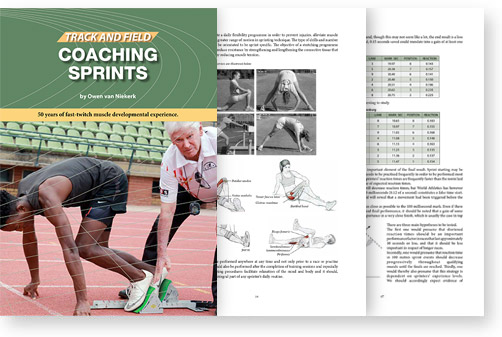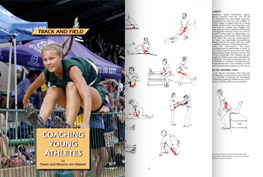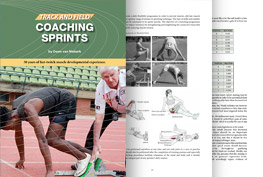Track and Field Coaching Sprints

Overview
 Purchase our ebook below for access to immediate download.
Purchase our ebook below for access to immediate download.
The book is provided in PDF format and licensed per user.
Payment is 100% secure. Please contact us for technical
support queries.
This book is for coaches, parents, sprinters and all the young beginners, to study the correct art of sprint training, to improve their athletic ability and natural talent. “I believe our country can have Olympic champions again just like in the past.” To become a world class sprinter the athlete should first be identified, tested and only then developed in the correct way. Any young athlete tested with fast-twitch muscle fibres can become a good sprinter. Correct coaching and development of this precious talent is of crucial importance.
In the past all track and field training was based on “fitness” for example endurance training which means that the slow-twitch fibres were developed properly but 90% of all track and field events depend on the fast-twitch muscle fibres that was not developed correctly. Owen therefore decided to do research on the development of the fast-twitch fibres that should be used for all sprints, hurdles, jumps and throwing events.
The world’s best athletes apart from middle and long distance runners, who performed exceptionally well, were from the nations born with a majority of fast-twitch muscle fibres. This book will explore the factors based on the fast-twitch fibres, how it works and how the development thereof must be done correctly. Doing training for endurance for example, slow-twitch fibres makes an athlete “fitter” but “slower”. We now find that middle distance athletes should develop more speed and will then be running times much faster than in the past because of their inherited and developed speed component.
This book includes chapters on Energy Systems for speed development. These correct training regimens of fast fibres are not only important for all speed events, not only sprints and hurdles, but also for jumpers and throwers. It also includes the conditioning of the fast fibres through bounding and weight training and the recovery thereof. With correct and better training programmes and technique for sprinters, the mental aspects are dealt with as well.
I sincerely hope that our new and younger coaches will change their attitude of coaching fast fibre athletes because we still hear of young boys and girls being chased by doing for example, 20 °— 200 and running kilometres a day and that for a sprinter who, “doesn’t breathe”, during a 100 metre race. South African talent is becoming “slower and fitter” but not “faster”. Only certain athletes who are born with fast-twitch muscle fibres and who are doing the correct training will be able to win Olympic titles in the future. We have a proud history of good sprinters as indicated at the end of this book.
Table of Contents
Chapter 1 General
Chapter 2 The Energy Systems
Chapter 3 Identification of Talent
Chapter 4 The Development of a Sprinter
Chapter 5 Warm-up and Stretching
Chapter 6 The Start
Chapter 7 The Reaction and Reflex
Chapter 8 Acceleration
Chapter 9 Top Speed
Chapter 10 Technique
Chapter 11 Sprint Drills
Chapter 12 Speed Endurance or Prolonged Speed
Chapter 13 The Last Few Metres and the Winning Line
Chapter 14 Conditioning
Chapter 15 Bounding and Plyometrics
Chapter 16 Recovery
Chapter 17 Programming
Chapter 18 Programmes
Chapter 19 Master Athletes and Speed
Chapter 20 Peaking
Chapter 21 Injuries
Chapter 22 Psychology of Sprinting
Chapter 23 Strength
Chapter 24 Testing Sprinters
Chapter 25 Coaching Tips
Chapter 26 Summary of Sprinting
Chapter 27 History of South African Sprinting
Chapter 28 Nurse Your Young Athletes Carefully
Price
$ 20.00 (approximately R360.00)
Featured Books
Track and Field Coaching Young Athletes
by Owen and Maryna van Niekerk
This book is for coaches, teachers and parents who have young athletes in their school or training groups. The book provides many well illustrated activities to use for the selection of young athletes for further coaching. A series of drills and coaching tips, suggestions for planning programmes, and methods for improving the level of safety are provided.
Featured Books
Track and Field Coaching Sprints
by Owen van Niekerk
This book is for coaches, parents, sprinters and all the young beginners, to study the correct art of sprint training, to improve their athletic ability and natural talent. To become a world class sprinter the athlete should first be identified, tested and only then developed in the correct way.






